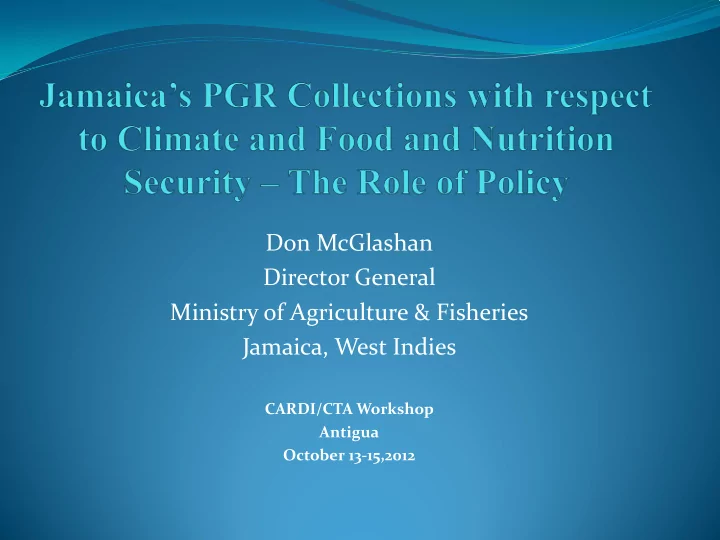

Don McGlashan Director General Ministry of Agriculture & Fisheries Jamaica, West Indies CARDI/CTA Workshop Antigua October 13-15,2012
Jamaica’s PGR(FA) began in the 18 th Century………. Bath Botanical Gardens, (1779) Second oldest garden in the western hemisphere Original nursery for Artocarpus altilis, svzygium malacense, Blighia sapida
Bath Botanical Gardens
Castleton Botanical Gardens (1862) Established as a “backup” to Bath Bombay mango introduced in 1868, navel orange and tangerine, 1870 Strychnos sp , African velvet apple, mangosteen
Castleton Botanical Gardens
Cinchona (1868) Named after Cinchona officinalis Assam tree
Cinchona
Royal (Hope) Botanical Gardens (1881) Originally established as a plant introduction and crop testing facility for pineapple, cocoa, coffee, tobacco
Royal (Hope) Botanical Gardens
“Although, these gardens………….. They were the source of planting material for fruit production in Jamaica’s agriculture past. Indeed, the gardens need to be treasured by our Jamaican people, for in them lie a source for food security.
Purpose of the collections To conserve PGR and facilitate their sustainable utilization towards food security and nutrition.
Major PGRFA Sugar Banana Coffee Cocoa Citrus Coconut ………. traditional export crops
Traditional and Domestic PGRFA Cassava Red peas Ackee yam Pigeon peas Mango Sweet potato Cow pea Breadfruit Dasheen Peanuts All spice Coco Corn Otaheite Irish potato Escallion Annonas ginger Thyme Avocado Scotch bonnet pepper Lychee Papaya
“New” PGRFA (Last 10 years) Hot peppers (‘W.I. Red’, ‘Scotch Bonnet’, ‘Jamaica Chocolate’) Sorrel (‘Bashment’) Tomato (TYLCV tolerant/resistant cultivars) Pumpkin (Bodles Globe, BF, BGG, BP, SB Callaloo (‘Cow Tongue’, ‘Coolie’) Irish potato (Peru, Columbia) June plum and other fruit trees
Custodians of PGR PGRFA Collector No. of Accessions Field Tissue Culture Genebanks/ seeds Research & Development • Legumes & grasses 35 • Hot pepper 13 • Pumpkin 5 • Sweet potato 25 • Cassava 21 • Fruit trees >80 SRC • Musa sp 82 • Cassava 23 • s/potato 22 • I/potato 21 • Pineapple 4 • Yam 4 • Medicinal Plants 10
Custodians of PGR (Cont’d) PGRFA Collector No. of Accessions Field Tissue Culture Genebanks /seeds Coconut Board 65 Cocoa Board 12 √ Farmers, farmer unknown but organizations significant Botanical Gardens 58 CARDI (forages, s/potato 21
How well are we doing? Musa sp Objective – to find an alternative cultivar to Gros Michel which was being devastated by Panama Disease (Banana Board – mitigation of diseases, breeding and hence safeguard the industry) Over 150 accessions in field gene banks notably RG’s, FHIA’s Urgent need for molecular characterization and proper archival system Need for greater interface and collaboration with other genetic programs (eg. EmbRAPA)
FHIA Variety
Citrus ‘Ortanique’, ‘Temple” and ‘Ugli’ major contributors to world citrus industry; Sweet-seeded grapefruit, Denham Seedless, Valencia Approximately 40 accessions (32 imported) Climate change - citrus mainly rain-fed, so need for drought-tolerant varieties. With increased storms, continued likelihood of introduction of vector and new diseases.
Tissue Culture Lab (SRC)
“Eat what you grow- Grow what you eat” Food import bill nearing US$1 billion Low economic access to food (poverty 16.5%) leading to nutritional maladies Insufficient utilization, declining state of PGR facilities and loss of genetic resources Weak policy directives and absence of a clearly defined strategic approach to PGRFA’s conservation and utilization
The Way Forward……….. Mission – Develop and promote PGRFA as a viable tool for the transformation of the agricultural sector and thus positively impacting national and regional development.
The Way Forward……. (Cont’d) Mechanism/Actors – CTA, CARDI, IICA, FAO (Donor Agencies?) must be co-opted to sensitize the policy makers and the public to the strategic and economic importance of PGRFA Donor Agencies (having been sensitized) are to include in their work program/call for proposals, projects that support the mission. Agricultural universities and other agricultural institutions must re-align their curricula to include PGR related courses (plant breeding, seed technology, genebank management, IP, biotechnology)
Reason for Hope…………. Completed two reports on the state of PGRFA in Jamaica. Information sharing mechanism on PGR of Jamaica A network of institutions which conserve and/or use PGR in Jamaica Jamaica’s accession (2006) to the International Treaty on PGRFA Bill titled – “An act to provide for the protection of Jamaica “Plant Genetic Resources for Food and Agriculture and for connected matters” Inter alia , advise the Minister on matters of policy and legal measures that provide for the conservation and sustainable use of PGR and the equitable sharing of the benefits
Recommend
More recommend